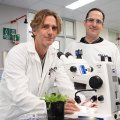Barbecues with friends and neighbours, chats over the fence, working bees and baby-sitting can not only make a small town closer socially, but stronger financially.
A University of Queensland study has found towns with more social capital, an estimation of the value of public involvement in social networks, were economically better off.
Residents in towns with high social capital, tended to be better educated, better paid and have more jobs than those in towns with low social capital.
The study, Social Capital and the Economic Development of Regional Australia, was the thesis for sociology student and principal policy officer with Queensland’s Department of State Development and Innovation, Dr Andrew Woodhouse.
It was conducted in two Darling Downs towns, each with a population of about 4500 people in 2002.
Dr Woodhouse spoke to residents, surveyed 244 residents by postal questionnaires and monitored local newspapers for six months.
He said towns with residents who spoke with neighbours, babysat, visited friends, helped at working bees or took part in community groups, and regularly travelled outside their community to visit other people, had higher levels of trust and greater social cohesion.
These conditions made it easier for residents to collaborate on community economic projects such as Christmas shopping campaigns or building a rural community centre.
“To foster economic development it’s important that small towns aren’t insular and are open to new and innovative ideas and new ways of looking at things,” Dr Woodhouse said.
Women with moderate incomes, who owned their homes and followed some form of religion, had the most social capital in small towns.
It was important that people were not only involved in social networks in their town but outside of their local communities as well.
“Social capital is generated through association between people. It’s about people reciprocating behaviours like looking after children or helping out their neighbours if they need a hand with something.”
He also found that crime rates could still be high in social capital towns, because it was often conducted by people who did not live in the community.
“That reinforced the sense of community amongst the people who lived there but it also meant that outsiders could be excluded from the mainstream community because of perceived views of their likely behaviour by residents of the town,” he said.
Dr Woodhouse’s research was done through the School of Social Science under the supervision of Dr Patrick Mullins (Social Science) and Dr Scott Baum (Geographical Sciences).
Media: contact Dr Woodhouse on (phone: 07 3234 1723, email: Andy.Woodhouse@qld.gov.au) or Miguel Holland at UQ Communications on (phone: 3365 2619, email: m.holland@uq.edu.au)
.jpg)



